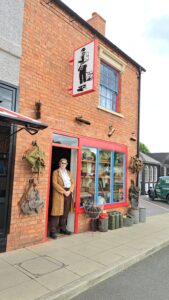Helen Annetts enjoys a day out in the past.
What a treat this morning to head to the Black Country Living Museum and explore three new shops on the 1940s–1960s high street, meticulously recreated as part of the museum’s Forging Ahead project which, when complete, will have seen the creation of 22 new buildings, the museum up to the 1960s.
The three new shops on the Black Country high street included a 1940s Co-op, a 1960s Post Office and a late 1960s Army & Navy Store, each one bringing a moment in history perfectly back to life from the signage that tempts you in, to the items on the shelves.
My first stop was the recreation of an iconic military surplus store – based on the store Henry Langer, a former German prisoner of war, opened in Stourbridge in the 1950s. The shop  itself – at the Black Country Living Museum – is set in 1967 and as soon as you step inside you stop in your tracks at the smell which is completely synonymous with any Army & Navy Store – and I know that smell as I have a young Army Cadet in my household so we’ve spent many an hour at the Army & Navy Store.
itself – at the Black Country Living Museum – is set in 1967 and as soon as you step inside you stop in your tracks at the smell which is completely synonymous with any Army & Navy Store – and I know that smell as I have a young Army Cadet in my household so we’ve spent many an hour at the Army & Navy Store.
The shop is filled with all things Army and Navy from jackets to boots, badges to bags, and as I was advised by shopkeeper Charlie Milward (one of the Museum’s historical characters), 1967 saw the release of The Beatles Sgt. Pepper’s Lonely Hearts Club Band so the military style jackets would have been hugely in demand!
I then popped next door to Spring Hill Post Office. The first thing to catch your eye on your way in is the ‘Wendy Box’ outside the window. Everyone of a certain age has seen these, there was a boy version and a girl version representing a child with cerebral palsy, a way of collecting money for the then-named ‘Spastics Society’ and today it’s quite shocking to see this outside a shop. The boxes were actually phased out from 1979 so there will be generations of people who will be stopped short by the language used. In 1994 the Spastics Society changed its name to Scope and the focus has subsequently been very much about positive representations of disabled people.
Inside Spring Hill Post Office there are toys, stationery and sweets! Lots to actually buy but also a section with representations of cigarettes and chocolates from 1965 and whilst the names will be familiar you will be shocked by the sizes. Let me tell you a flake and a Mars bar in 1965 were HUGE. We are definitely shortchanged in the modern age.
The post office itself is wonderful, there are examples of air mail, dog licences, a 60s saving book, telegrams, the upgraded ‘special event’ telegrams and of course the opportunity to send a postcard. Which of course I did, duly stamped by the postmistress and posted outside the shop.
My final stop of the new shops is the 1940s Halesowen and Hasbury Co-op, which in the 40s was pioneering the idea of self-service so on entering the shop you pick up your basket and head off to see what is available on your ration card and via the point system, both still in place until 1954, when the last thing to come off the ration card was meat. Some items would have been hard to come by; pick up a recipe card and see what items are available – can you get everything you need? And the point system, that was in place in the 40s during and post war, is a clever way to understand fluctuations in availability and popularity of food.
As I meandered back to the exit past the fairground, the working horses, the tram and the mine I was reminded how much history there is at the Black Country Living Museum, it feels like an age since my boys visited the mine, went on the fair, played early 1900 street games and visited the canal.
It was and is a brilliant day out. It’s going on our list for the summer, I would strongly recommend a visit. And as they approach the 1970s, I shall try not to worry about my childhood literally becoming history.
Visit the website for information on ticket prices, opening hours and everything else you might need to know at bclm.com.


